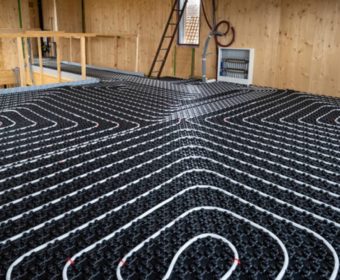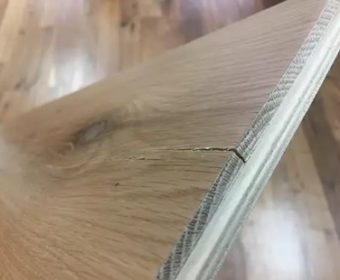Wood flooring is a popular choice for many homeowners, and for good reason. It adds warmth, character, and style to any space. However, when it comes to installing wood flooring over radiant heated floors, there are some risks involved that homeowners should be aware of. In this blog, we’ll discuss these risks and provide some best practices for caring for wood flooring over radiant heated floors long-term.
What are Radiant Heated Floors?
Radiant heating systems use hot water or electrical wiring to heat a home from the floor up. There are two types of radiant heating systems: electric and hydronic. Electric radiant heating systems use electrical wiring embedded in the floor, while hydronic radiant heating systems use hot water circulated through tubing.

Why is Installing Wood Flooring Over Radiant Heated Floors Risky?
When installing wood flooring over radiant heated floors, there are several risks that homeowners should be aware of. These risks include:
-
Gapping and Buckling
Wood flooring expands and contracts in response to changes in temperature and humidity. When wood flooring is installed over radiant heated floors, it is exposed to heat from below. This can cause the wood to expand more than it would under normal conditions, leading to gaps between the boards. On the other hand, when the radiant heating system is turned off, the wood can contract, leading to buckling or warping.
-
Cracking
When wood flooring is exposed to extreme heat, it can crack or split. This can happen if the temperature of the radiant heated floors is too high or if the wood flooring is not properly acclimated before installation.
Best Practices for Installing Wood Flooring Over Radiant Heated Floors
Despite the risks involved, it is possible to install wood flooring over radiant heated floors. Here are some best practices to follow:
-
Choose the Right Type of Wood Flooring
Not all wood flooring is suitable for installation over radiant heated floors. Engineered wood flooring is the best option, as it is more stable and less likely to expand and contract than solid wood flooring. Look for engineered wood flooring with a thick wear layer to ensure that it will stand up to the wear and tear of everyday use.
-
Acclimate the Flooring
Before installation, the wood flooring should be acclimated to the environment in which it will be installed. This means leaving the wood in the room where it will be installed for several days to allow it to adjust to the temperature and humidity. This will help reduce the risk of gapping, buckling, and warping.

-
Monitor the Temperature
It is important to monitor the temperature of the radiant heated floors to ensure that it is not too high. A temperature of 85°F is generally considered safe for engineered wood flooring. If the temperature exceeds this, it can cause the wood to crack or split. When using the heated system, make sure to let the temperature rise slowly.
-
Maintain the Humidity Level
Maintaining the humidity level in the room is also important. The ideal humidity level for wood flooring is between 30% and 50%. Use a humidifier or dehumidifier to maintain this level, as necessary. Avoid using harsh cleaning products or excessive amounts of water, which can raise the humidity level and increase the risk of cupping.
-
Use a Moisture Barrier
A moisture barrier should be installed between the wood flooring and the radiant heated floors. This will help prevent moisture from penetrating the wood and causing cupping or warping. A moisture barrier can also help prevent the transfer of heat from the radiant heating system to the wood flooring, which can reduce the risk of gapping and buckling. There are specific radiant heat underlayments that are used during installations and will not be your standard moisture barrier. It is very important to use the correct underlayment to protect your flooring from the excess heat.
Best Practices for Caring for Wood Flooring Over Radiant Heated Floors
In addition to following best practices for installation, there are also some best practices for caring for wood flooring over radiant heated floors long-term. These include:
-
Regular Cleaning
Regular cleaning is important to maintain the appearance and durability of wood flooring. Use a soft-bristled broom or vacuum with a hardwood floor attachment to remove dirt and debris. Avoid using harsh cleaning products or excessive amounts of water, which can damage the wood flooring.
-
Maintain the Radiant Heating System
Maintaining the radiant heating system is also important to ensure that it is functioning properly and not causing damage to the wood flooring. Have the system serviced regularly by a professional to ensure that it is working efficiently and safely.
Conclusion
Installing wood flooring over radiant heated floors can be risky, but by following best practices for installation and care, homeowners can enjoy the beauty and warmth of wood flooring without worrying about damage. If ever in doubt, consult with your warranty guide through the manufacturer or reach out to Unique Wood Floors and we will be happy to give you all the knowledge you need to successfully care for your heated flooring.
